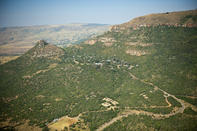Minerals, Safety and Game
The Ithala Reserve was continually occupied during major events of the 19th and 20th century. During the Iron Age, the area’s natural resources of iron and ore were used for smelting operations.

It was also home to the San with traces of rock art at various sites in the eastern parts of the reserve. People fleeing the Zulu wars and King Shaka found safety in the caves along the cliffs of Ithala. In the mid-1800s, the Zulu king Dinizulu gave over 1.1 million hectares to 800 Boer settlers.
Game was bountiful in the late 1800s, but after a Rinderpest epidemic and other disease outbreaks, thousands of animals had to be culled. In the early 1900s, gold was discovered in the area. Various farms and mines near Pongola River were mined with little success for over 20 years, and other mines in the surrounding areas such as Wonder Mine and Vergelegen Mine produced even less gold.
The farms in the Ithala are were mostly used as labour/tenant farms. When Ithala was manifested, conservationists felt the reserve would benefit the preservation of the variety of habitats represented. Veld that was damaged due to overgrazing was left to recover while the reserve was fenced. During the years, 25 animals had become extinct in the area.
By the early 1980s, Ithala reserve had been extended to almost 30 000 ha. Since then the reserve became one of KwaZulu Natal's major wildlife destinations. When the reserve opened, 23 mammal species were re-introduced into the wild, including rhino, buffalo, kudu, tsessebe, red hartebeest, eland, giraffe, leopard, cheetah and brown hyena and more recently, elephant.
By David Bristow